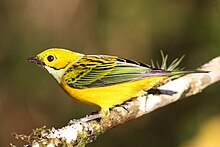Silver-throated tangare
| Silver-throated tangare | ||||||||||||
|---|---|---|---|---|---|---|---|---|---|---|---|---|

Silver-throated tangara ( Tangara icterocephala ) |
||||||||||||
| Systematics | ||||||||||||
|
||||||||||||
| Scientific name | ||||||||||||
| Tangara icterocephala | ||||||||||||
| ( Bonaparte , 1851) |
The silver- throated tangar ( Tangara icterocephala ) is a species of bird from the family of the tangar (Thraupidae) that occurs in Central and South America .
features
The silver-throated tangare reaches a body length of about 13 centimeters and a weight of 17.7 to 24.7 grams. The birds have a predominantly yellow plumage. The golden yellow head and the silvery white throat are typical of the species. A black, mustache-like stripe extends from the base of the beak to the center of the head. The back plumage is brownish piebald, the arm and hand wings as well as the control feathers are bordered brown and yellow-green. The sexes hardly differ in color, but the females show somewhat paler colors.
Distribution, subspecies and habitat
In addition to the to the east of Panama , in the Andean regions of Colombia and in the west of Ecuador occurring nominate Tangara cyanocephala cyanocephala two more subspecies known:
- Tangara icterocephala frantzii ( Cabanis , 1861), in northern Costa Rica and on mountain slopes in the province of Veraguas
- Tangara icterocephala oresbia Wetmore , 1962, in the mountains of western Panama.
Silver-throated tangars prefer to colonize moist forests, forest edges and mountain slopes at altitudes between 150 and 2100 meters.
Way of life
The birds feed primarily on fruits, and to a lesser extent also on arthropods . They live in pairs or in small groups, sometimes in company with other species of Tangaren. Depending on the climatic conditions and altitude, one or two broods are carried out a year, in Colombia, for example, between February and April and in October. The nest is made from moss, leaves and silk from spider webs within three to six days and placed in bushes or trees at heights between one and eleven meters above the ground and provided with two eggs. These are whitish or pale gray in color and have some brownish spots. Only the female breeds. The incubation period is 13 to 14 days. Nestlings are provided with food by both parents and fly out after 15 days.
Hazard and protection
The silver-throated tangar is not uncommon in protected areas and national parks and is therefore classified by the IUCN as a ![]() “ Least Concern ”. Outside the protected areas, however, a decline in the species can already be observed due to the reclamation of the habitat .
“ Least Concern ”. Outside the protected areas, however, a decline in the species can already be observed due to the reclamation of the habitat .
Individual evidence
- ↑ Hilty, S. 2017 Silver-throated Tanager (Tangara icterocephala). In: del Hoyo, J., Elliott, A., Sargatal, J., Christie, DA & de Juana, E. (eds.). Handbook of the Birds of the World Alive. Lynx Edicions, Barcelona. (accessed from http://www.hbw.com/node/61688 on February 12, 2017).
- ^ IUCN Red List
literature
- Josep del Hoyo , Andrew Elliott, David A. Christie: Handbook of the Birds of the World, Tanagers to New World Blackbirds. Volume 16, Lynx Edicions, 2011, ISBN 978-84-96553-78-1 .
Web links
- neotropical.birds - Neotropical Birds
- itis.gov - ITIS Report
- xeno-canto - spread
